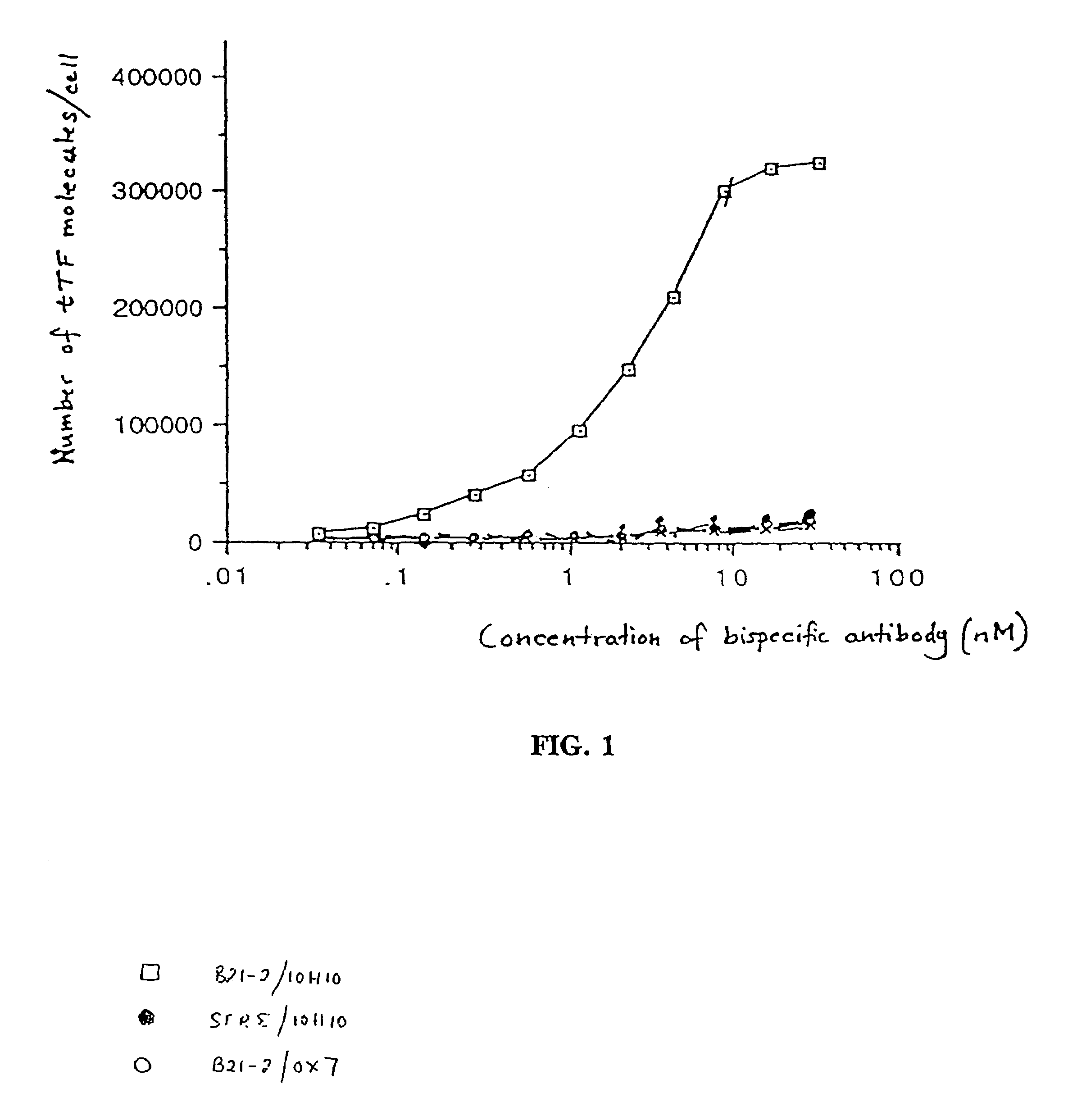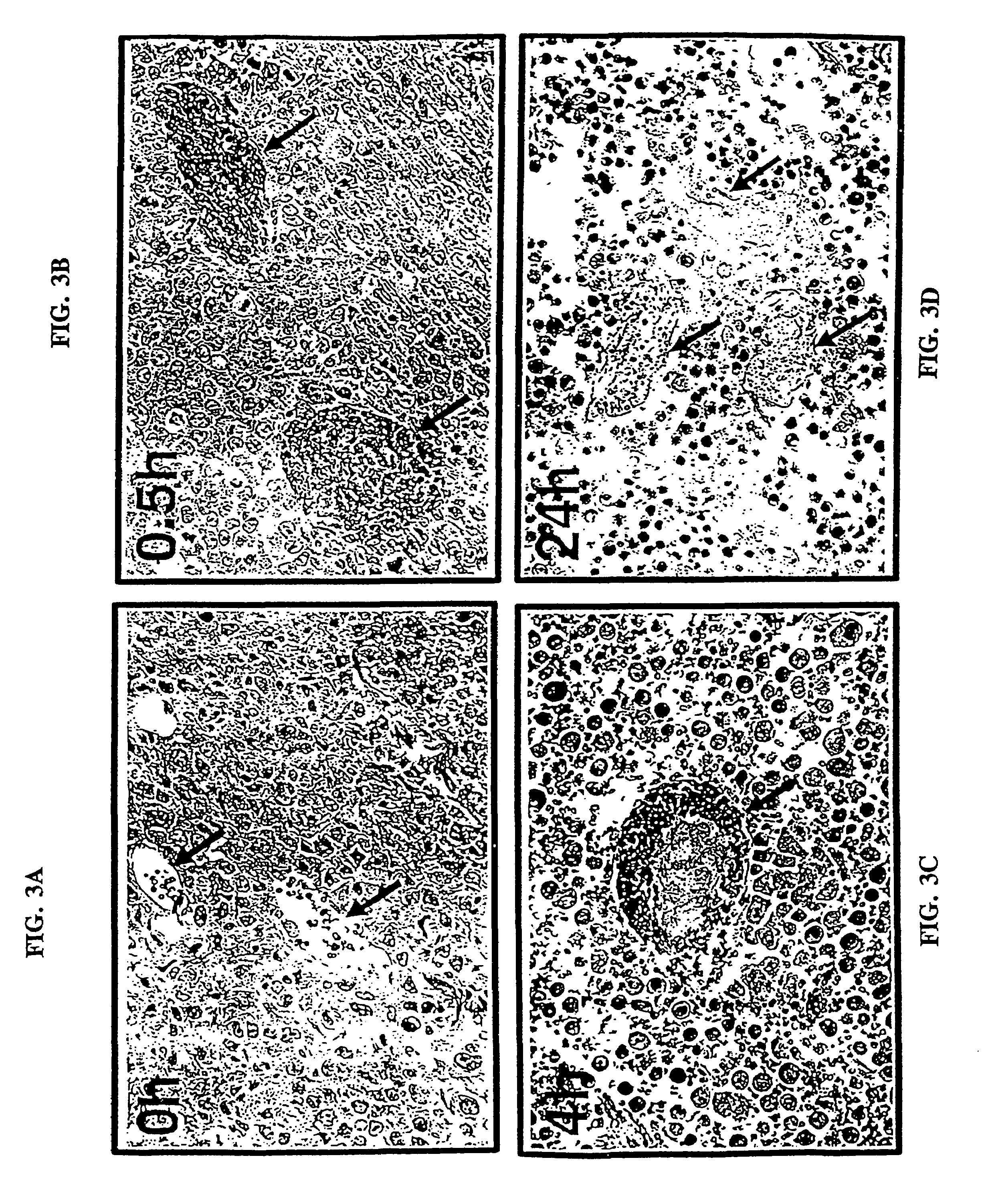Combined methods for tumor coagulation and tumor treatment
a combination method and tumor technology, applied in the field of blood vessels and of coagulation, can solve the problems of many of the most prevalent forms of human cancer that resist effective chemotherapeutic intervention, is much more difficult for most chemotherapeutic agents to reach all, and is difficult to achieve the effect of all chemotherapeutic agents
- Summary
- Abstract
- Description
- Claims
- Application Information
AI Technical Summary
Benefits of technology
Problems solved by technology
Method used
Image
Examples
example i
Synthesis of a Bispecific Coagulating Antibody
[0406]The present example describes the synthesis of a bispecific antibody capable of specifically directing a coagulant to a tumor site, i.e., a “coaguligand”.
A. Materials and Methods
1. Reagents
[0407]Pepsin (A; EC 3.4.23.1), Ellmans reagent (ER; 5,5′-dithio-bis(2-nitrobenzoic acid, DNTB), 2-mercaptoethanol (2-ME), sodium arsenite (NaAsO2) and rabbit brain thromboplastin (acetone powder) were obtained from Sigma Chemical Co., St. Louis Mo. Sephadex G-25 and G-100 were obtained from Pharmacia LKB (Piscataway, N.J.).
2. Human Truncated Tissue Factor (tTF)
[0408]Recombinant human truncated TF (tTF) was prepared by one of two different methods.[0409]Method I: Construction of the E. coli Expression Vector. The cDNA coding for tTF (residues 1-218) was amplified by PCR using the primers 5′-GAAGAAGGGATCCTGGTGCCTCGTGGTTCTGGCACTACAAATACT-3′ (5′-primer; SEQ ID NO:28) and 5′-CTGGCCTCAAGCTTAACGGAATTCACCTTT-3′ (3′-primer; SEQ ID NO:29) which allowed the...
example ii
Coagulating Antibody Binding and Function In Vitro
[0433]The present example shows the bispecificity of the coagulating antibody (coaguligand) and demonstrates that specific binding, cellular delivery and coagulation is achieved in vitro using the coaguligand.
A. Materials and Methods
1. Cells
[0434]The A20 cell line, which is an I-Ad positive BALB / c B-cell lymphoma, was purchased from the American Type Culture Collection (ATCC; Rockville, Md.; TIB-208). A20 cells were grown in DMEM supplemented with 10% (v / v) fetal calf serum (FCS), 0.2 mM L-glutamine, 200 units / ml penicillin and 100 μg / ml streptomycin, 18 mM Hepes, 0.1 mM non-essential amino acids mix and 1 mM sodium pyruvate (medium hereafter referred to as complete DMEM; all reagents obtained from Life Technologies, Gaitherburg, Md.). 2-ME is added to complete DMEM to a final concentration of 0.064 mM for A20 cells. Cultures were maintained at 37° C. in a humidified atmosphere of 90% air / 10% CO2.
[0435]J82, a human gall bladder carci...
example iii
Specific Tumor Vasculature Specific Coagulation In Vivo
[0451]The present example describes the specific coagulation of tumor vasculature in vivo that results following the administration of the bispecific antibody coaguligand as a delivery vehicle for human tissue factor.
A. Materials and Methods
1. Reagents
[0452]Mouse blood was obtained by heartpuncture and collected in 1 / 10 volume of 3.8%. buffered citrate. The blood was centrifuged for 10 min at 3000 g and the plasma snap frozen in small aliquots and stored at −70° C.
2. Animals
[0453]BALB / c nu / nu mice were obtained from Simonsen (Gilroy, Calif.) and maintained under SPF conditions.
3. C1300 (Muγ) Mouse Model and Treatment
[0454]The tumor model was as previously described (Burrows et al., 1992; Burrows & Thorpe, 1993) with three refinements. First, a different antibody, B21-2, was used. This antibody recognizes I-Ad but not I-Ed, unlike the previously used M5 / 114 antibody which recognizes both molecules. The B21-2 antibody has an appro...
PUM
| Property | Measurement | Unit |
|---|---|---|
| diameter | aaaaa | aaaaa |
| pH | aaaaa | aaaaa |
| pH | aaaaa | aaaaa |
Abstract
Description
Claims
Application Information
 Login to View More
Login to View More - R&D
- Intellectual Property
- Life Sciences
- Materials
- Tech Scout
- Unparalleled Data Quality
- Higher Quality Content
- 60% Fewer Hallucinations
Browse by: Latest US Patents, China's latest patents, Technical Efficacy Thesaurus, Application Domain, Technology Topic, Popular Technical Reports.
© 2025 PatSnap. All rights reserved.Legal|Privacy policy|Modern Slavery Act Transparency Statement|Sitemap|About US| Contact US: help@patsnap.com



